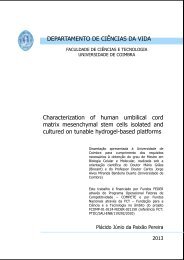role of th1 and th17 cd4+ t cell subsets in the pathogenesis of ...
role of th1 and th17 cd4+ t cell subsets in the pathogenesis of ...
role of th1 and th17 cd4+ t cell subsets in the pathogenesis of ...
You also want an ePaper? Increase the reach of your titles
YUMPU automatically turns print PDFs into web optimized ePapers that Google loves.
CNS. F<strong>in</strong>ally, it was found that transferred Th17 <strong>cell</strong>s can convert to a Th1 phenotype <strong>in</strong><br />
<strong>the</strong> host, suggest<strong>in</strong>g plasticity <strong>in</strong> <strong>the</strong> Th17 <strong>cell</strong> subset <strong>and</strong> emphasiz<strong>in</strong>g a pathogenic <strong>role</strong><br />
for Th1 <strong>cell</strong>s.<br />
Next, tak<strong>in</strong>g <strong>in</strong>to account our data <strong>and</strong> earlier f<strong>in</strong>d<strong>in</strong>gs previous to <strong>the</strong> Th17 <strong>cell</strong><br />
discovery that demonstrated a cytotoxic capacity <strong>of</strong> auto‐antigenic T <strong>cell</strong>s over<br />
astrocytes, important CNS resident glial <strong>cell</strong>s, we asked which <strong>of</strong> <strong>the</strong> CD4 + T <strong>cell</strong> subset<br />
was cytotoxic to astrocytes. By establish<strong>in</strong>g an <strong>in</strong> vitro co‐culture <strong>of</strong> myel<strong>in</strong>‐specific Th1<br />
<strong>and</strong> Th17 <strong>cell</strong>s with GFP positive‐astrocytes, it was possible to pursue cytotoxicity by<br />
fluorescent time‐lapse microscopy. It was found that Th1 but not Th17 <strong>cell</strong>s were<br />
cytotoxic to astrocytes, fur<strong>the</strong>r emphasiz<strong>in</strong>g <strong>the</strong> pathogenic <strong>role</strong> <strong>of</strong> Th1 <strong>cell</strong>s.<br />
F<strong>in</strong>ally, <strong>in</strong> order to identify molecules that are differently regulated <strong>in</strong> Th1 <strong>and</strong> Th17<br />
<strong>cell</strong>s <strong>and</strong> to underst<strong>and</strong> which different <strong>role</strong>s <strong>the</strong>se <strong>cell</strong>s might play <strong>in</strong> EAE, a<br />
transcriptome analysis by microarrays <strong>of</strong> both populations was performed. We found<br />
<strong>the</strong> nuclear receptor Rev‐Erbα to be expressed <strong>in</strong> Th17 but not <strong>in</strong> Th1 <strong>cell</strong>s. A pathway<br />
analysis revealed a relationship <strong>of</strong> Rev‐Erbα with RORα, an important transcription<br />
factor for Th17 differentiation, but no def<strong>in</strong>ite <strong>role</strong> for this molecule <strong>in</strong> regulat<strong>in</strong>g Th17<br />
differentiation could be established.<br />
In conclusion, this <strong>the</strong>sis demonstrates, contrary to <strong>in</strong>itial evidence, that both myel<strong>in</strong>‐<br />
specific Th1 <strong>and</strong> Th17 CD4 + T <strong>cell</strong> <strong>subsets</strong> are able to <strong>in</strong>duce pathogenicity <strong>in</strong> EAE,<br />
though with different capabilities to mediate disease. Also, Th1 <strong>cell</strong>s are true cytotoxic<br />
effector <strong>cell</strong>s destroy<strong>in</strong>g astrocytes, important neuronal buffer <strong>cell</strong>s. A new gene was<br />
also discovered, Rev‐Erbα, which is differently regulated by Th1 <strong>and</strong> Th17 <strong>cell</strong>s. Though<br />
no impact <strong>of</strong> Rev‐Erbα <strong>in</strong> Th17 differentiation could be determ<strong>in</strong>ed, a possible <strong>role</strong> <strong>in</strong><br />
Th17 biology will need to be fur<strong>the</strong>r addressed.<br />
12

















